
Fuxing EMU drove into Shennongjia Station, photo courtesy of China National Railway Group
Reporter | Tang Jun
On June 20, the Zhengzhou-Chongqing high-speed railway from Xiangyang east to Wanzhou north (hereinafter referred to as the Xiangwan section of the Zhengzhou-Chongqing high-speed railway) was completed and opened, and the Zhengzhou-Chongqing high-speed railway achieved full operation. The travel time from Chongqing to Beijing, Shijiazhuang, Zhengzhou and other places has been greatly reduced, and high-speed trains have been welcomed in scenic spots such as Shennongjia and the Three Gorges.
Open up a new channel from Chongqing to the north
The Zheng-Chongqing high-speed railway starts from Zhengzhou City, Henan Province in the north, and ends in Chongqing City in the south, passing through Henan, Hubei, and Chongqing, with a total length of 1,068 kilometers.
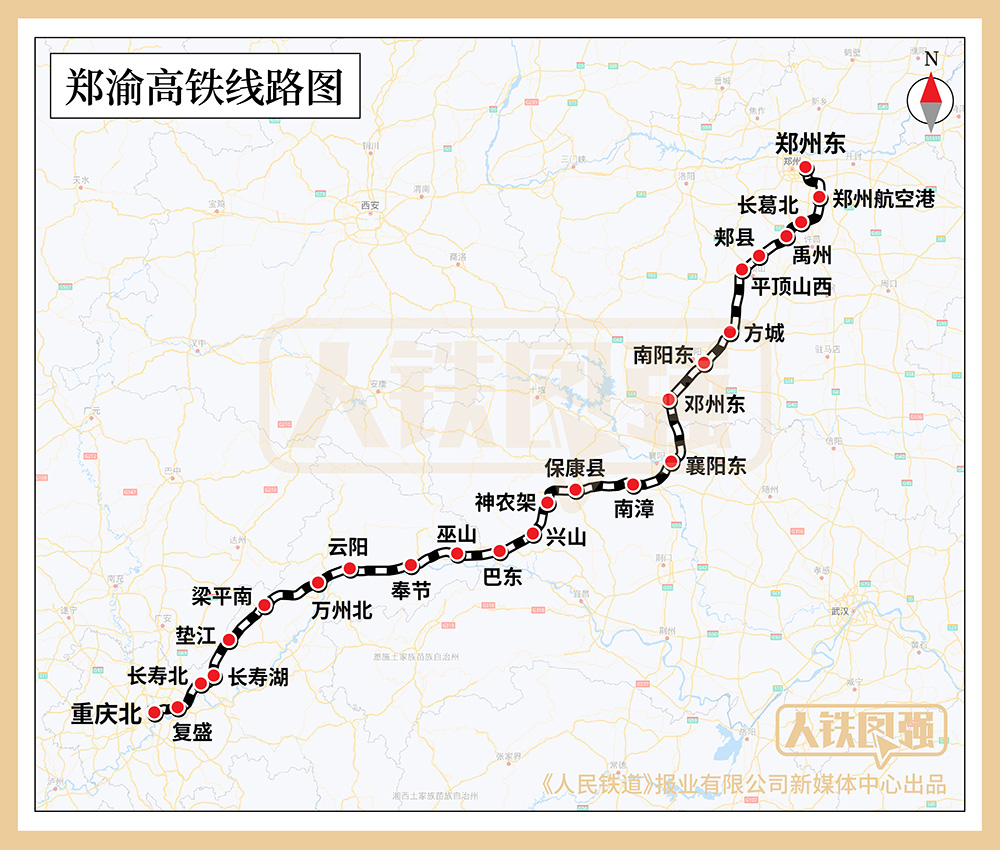
The section from Chongqing North to Wanzhou North was opened on November 28, 2016, with a design speed of 250 kilometers per hour, compared to the previous operating speed of 210 kilometers per hour. From June 20, the operating speed of this section of high-speed rail will be increased to 250 kilometers per hour.
The Zhengzhou East to Xiangyang East section was opened on December 1, 2019, with a design speed of 350 kilometers per hour and a maximum operating speed of 310 kilometers per hour.
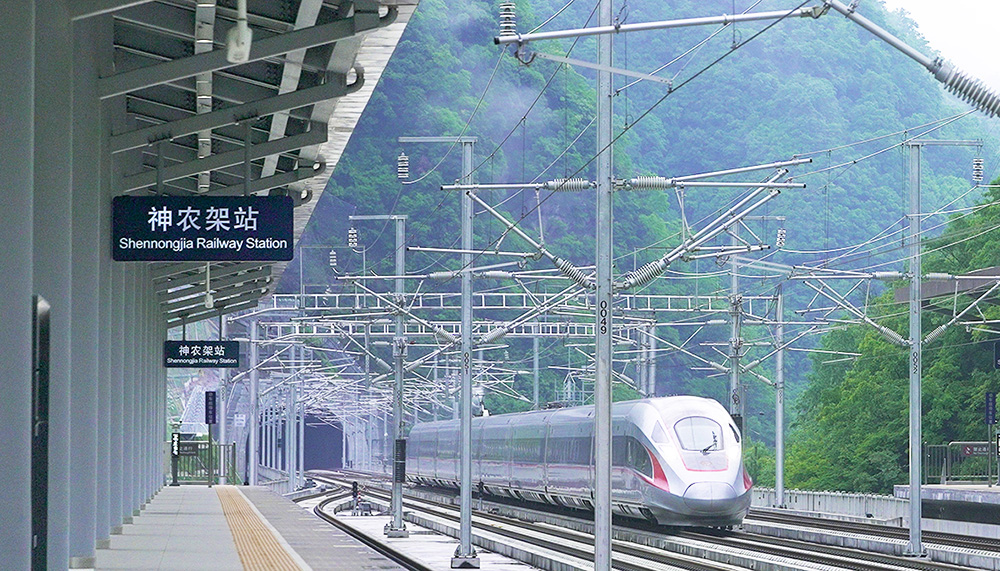
The opening of the Xiangyang East to Wanzhou North section has a total length of 434 kilometers, a design speed of 350 kilometers per hour, and is opened for operation at a speed of 310 kilometers per hour. This section of high-speed railway passes through Xiangyang City, Jingmen City, Yichang City, Enshi Tujia and Miao Autonomous Prefecture in Hubei Province and Wushan County, Fengjie County, Yunyang County and Wanzhou District in Chongqing City, with 10 stations.
Before the opening of the Xiangwan section of the Zhengzhou-Chongqing high-speed railway, when Chongqing goes north to Beijing, it needs to bypass Chengdu, Xi’an and then Zhengzhou. Now, there is a direct high-speed rail connection between Chongqing and Zhengzhou, and the Beijing-Guangzhou high-speed rail Jingwu section has been accelerated to 350 km/h on June 20. Travel time from Chongqing to major cities in central and northern China has also been greatly shortened.
Previously, the high-speed train from Beijing to Chongqing took 11 hours and 11 minutes, but now it only takes 6 hours and 46 minutes; the high-speed train from Shijiazhuang to Chongqing has been shortened from 9 hours and 49 minutes to 5 hours and 43 minutes, and the time from Zhengzhou to Chongqing has been shortened from 7 hours. Hours and 28 minutes were shortened to 4 hours and 23 minutes.
As the actual travel distance is shortened, the fares of the above-mentioned routes are also greatly reduced. The fare for the second-class seat of the Zhengzhou-Chongqing high-speed rail was between 630-663 yuan before. After the Zhengzhou-Chongqing high-speed rail line was opened, the fare from Zhengzhou East to Chongqing North was between 418-570 yuan.
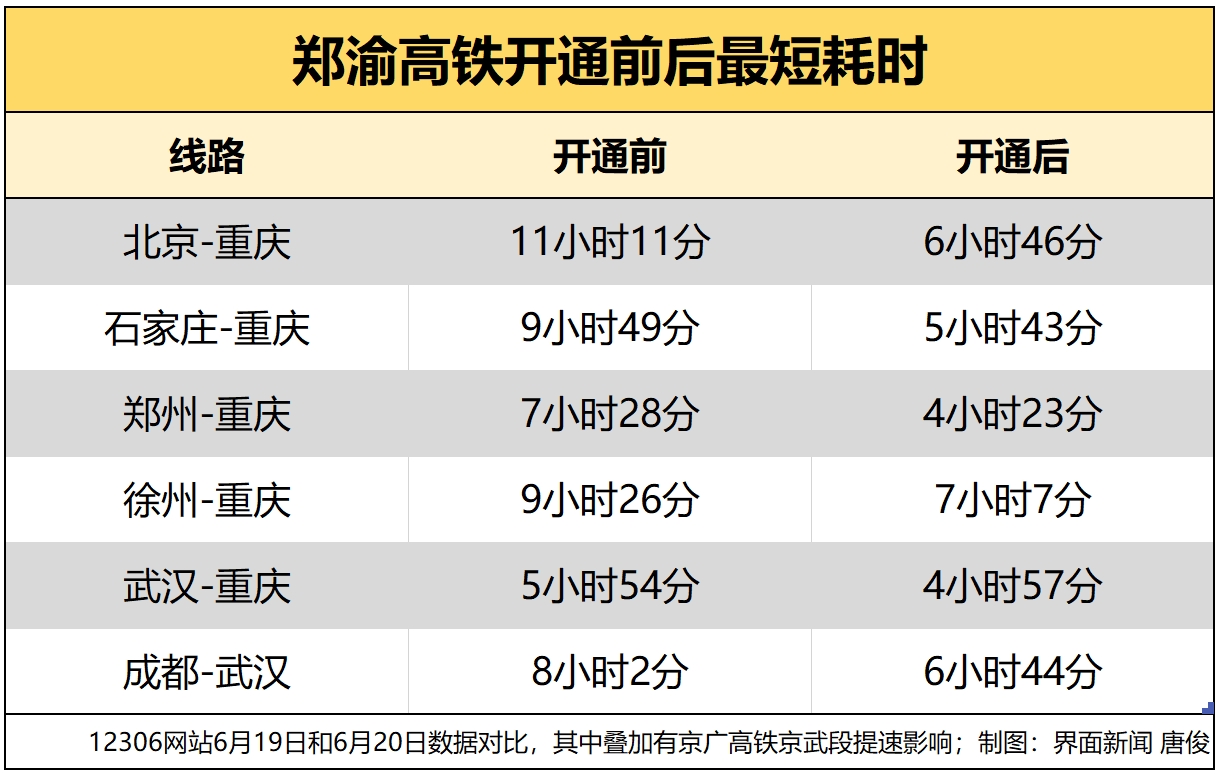
High-speed trains from Chengdu-Chongqing to Wuhan were previously only able to travel on the Shanghai-Hanlong-Chengdu Railway. The design speed of this section of the railway is relatively low, and the distance from Wuhan to Chongqing of more than 800 kilometers will take nearly 6 hours at the fastest. Now Wuhan can also go to Chongqing via the Han-Shi High-speed Railway and Zheng-Chongqing High-speed Railway. Although the mileage has reached more than 900 kilometers, the shortest time can be reduced to about 5 hours.
Similarly, the travel time from Chengdu to Wuhan via the Zhengyu high-speed rail can also be shortened by more than an hour. But shorter routes are more expensive because they have longer miles and faster speeds. The ticket price for a second-class seat from Chongqing to Wuhan via the Zhengyu high-speed rail will be about 200 yuan more expensive than that of the high-speed rail via the Shanghai-Hanlong-Chengdu railway to Wuhan.
Crossing the Daba Mountains, the bridge-to-tunnel ratio is as high as 98%
The Xiangwan section of the Zhengyu high-speed railway is located in the mountainous areas of western Hubei and eastern Chongqing. It crosses many mountain ranges such as Daba Mountain, Wushan Mountain and Qiyue Mountain, spans many rivers such as Han River, Daning River and Meixi River, and passes through the virgin forest area of Shennongjia and many natural Protected area, you can see rich natural landscape along the way.
The Xiangwan section of the Zhengyu high-speed railway has high mountains and deep valleys, and the bridge-to-tunnel ratio is as high as 98%, which means that this section of the road is basically bridges and tunnels. A number of extra-large bridges have been erected on the line, including the Fengjie Meixi River Double-Line Super Bridge and the Baokang Lianghekou Double-Line Super Bridge, and a number of long tunnels such as the Small Three Gorges Tunnel and the Xinhua Tunnel have been built.
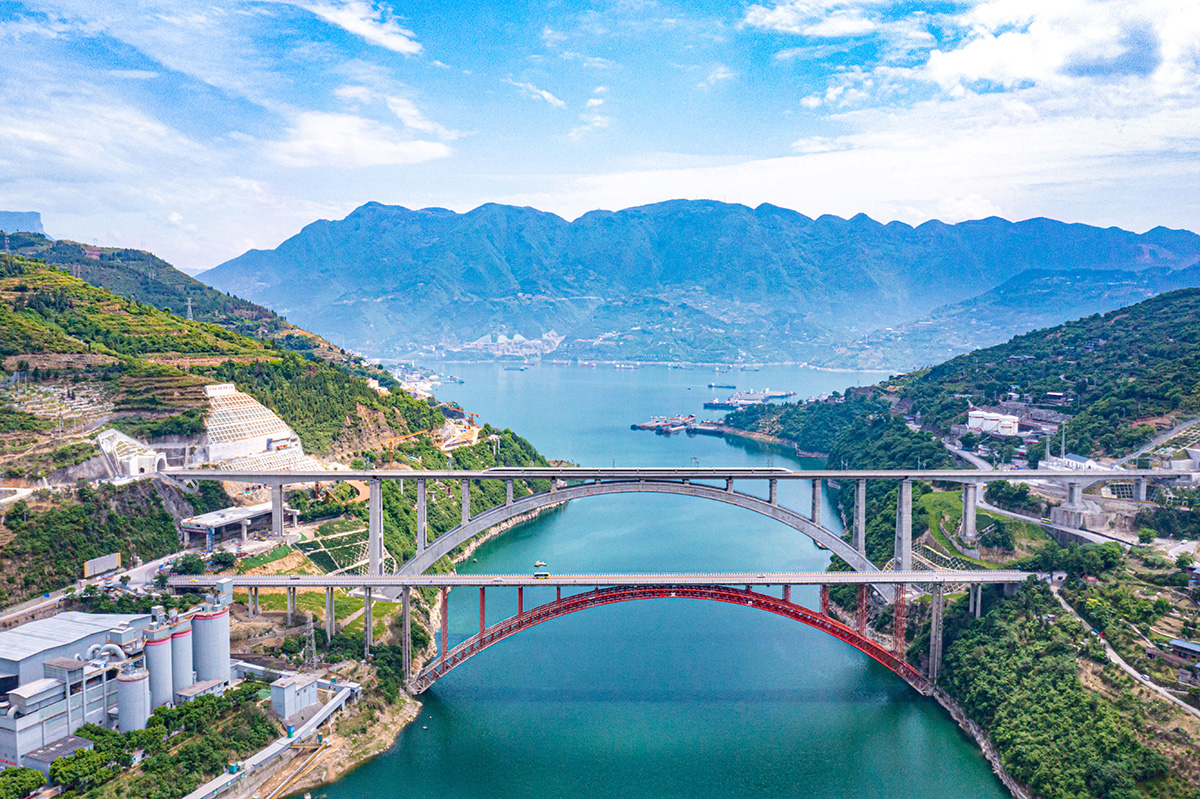
The test vehicle passes through the Meixi River Bridge on the Zhengyu High-speed Railway – Li Fubin/Photo courtesy of China Railway Group

The dynamic detection vehicle drives over the Daning River Bridge on the Zhengyu High-speed Railway-Huang Maocheng/Photo, Photo courtesy of China National Railway Group
Zhengyu high-speed railway is also a tourist line, connecting many famous tourist attractions such as Songshan Shaolin Temple, Xiangyang Gulongzhong, Shennongjia Primitive Forest, Fengjie Baidi City, Wushan Three Gorges and so on.
Shennongjia is a world natural heritage, and the Zheng-Chongqing high-speed rail station is here. In order to welcome the opening of the high-speed railway, the tourism department of Shennongjia has taken active actions-within one month of the opening of the Zheng-Chongqing high-speed railway, tourists from all over the country can visit Shennongjia Shennongding, Datong, Shennongjia, Shennongding, Shennongjia for free with their ID cards, tickets to Shennongjia high-speed railway station and arrival information. Nine lakes, Guanmen Mountain, Shennongtan, Tianshengqiao, Tianyan six core scenic spots.

The design concept of Shennongjia Station is “frame wood as a ladder, natural oxygen bar” – Li Yaojun / photo, photo courtesy of China Railway Group
The newly built Fengjie, Yunyang and Wushan stations of the Chongqing section of the Zhengyu high-speed railway are located in the hinterland of the Three Gorges Reservoir Area in Chongqing. After the high-speed rail is opened to traffic, the travel time to the landmarks of the Yangtze River such as Baidi City, Goddess Peak, Qutang Gorge and Wu Gorge will be greatly shortened.
For Fengjie, in addition to the Zhengyu high-speed railway, the An-Zhang Railway (Ankang to Zhangjiajie) and the Yanjiang Railway are also planned, which will become the intersection of the three railways in the future.
The completion of the Zhengyu high-speed railway will further improve the railway network structure in central and southwestern China, promote the development of tourism resources and industrial development, release the freight capacity of the Xiangyu normal-speed railway, and better promote the development of regional logistics.
The Puyang-Zhengzhou high-speed railway opens, and the country’s first rice-shaped high-speed railway network is completed
In addition to the Zhengzhou-Chongqing high-speed railway, the Zhengzhou-Puyang high-speed railway also opened on June 20, which is part of the Jinan-Zhengzhou high-speed railway. After the opening of the Puzheng section of the Jizheng high-speed railway, the fastest speed between Zhengzhou and Puyang is 52 minutes.
The Ji-Zheng high-speed railway is about 407 kilometers long and is constructed in two sections. The Puyang-Zhengzhou section opened this time is 195 kilometers long, with a design speed of 350 kilometers per hour and a maximum operating speed of 310 kilometers per hour, passing through Puyang, Xinxiang and Zhengzhou.
The Puzheng section of the Jizheng high-speed railway extends to the northwest of Zhengzhou. At this point, the Zhengzhou rice-shaped high-speed railway network has been officially completed. Specifically, the north-south direction of Zhengzhou is the Beijing-Guangzhou high-speed railway, the east is the Zhengxu high-speed railway, the west is the Zhengxi high-speed railway, the southeast is the Zhengfu high-speed railway, the northwest is the Zhengtai high-speed railway, and the southwest is the Zhengyu high-speed railway. These high-speed rail lines have been opened to traffic.
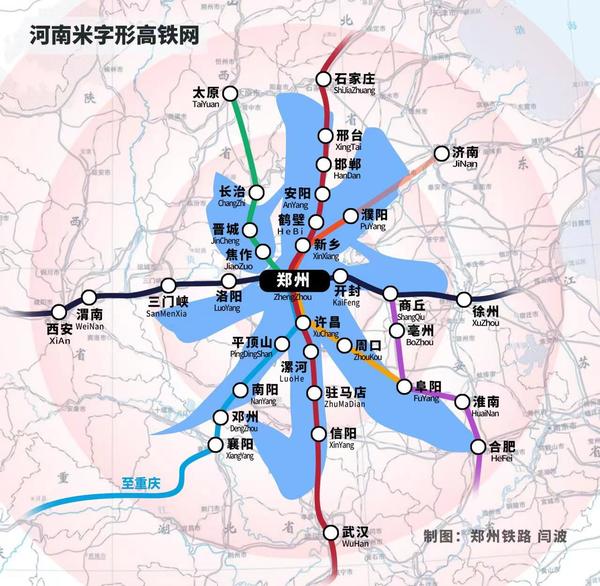
Including Wuhan, Changsha, Nanjing, Chongqing and other cities, many cities across the country have proposed to build a rice-shaped high-speed rail network. Zhengzhou is the first city to build a rice-shaped high-speed rail network. Zhengzhou is known as a city drawn by trains. In the era of high-speed rail, Zhengzhou once again seized the opportunity and built a high-speed rail network extending in all directions.
On June 20, Zhengzhou Airport Station, a passenger hub connecting Zhengzhou-Chongqing High-speed Railway, Zhengzhou-Fu High-speed Railway and Zhengzhou Intercity Railway, was also put into operation, forming a new pattern of Zhengzhou Railway Passenger Transport Hub with Zhengzhou Railway Station and Zhengzhou East Railway Station.
Zhengzhou Airport Station, formerly known as Zhengzhou South Station, is located in the Zhengzhou Airport Economic Comprehensive Experimental Zone and started construction in November 2017. In order to enhance the designation of the station name, the local government negotiated with the railway department and decided to change the name of the station to Zhengzhou Airport Station.
Zhengzhou Airport Station has a total of 32 arrival and departure lines and 30 passenger terminal platforms. The station building has a total of elevated waiting floors, platform floors, entry and exit hall floors, and subway transfer floors from top to bottom. The building area of the station building is 149,000 square meters, and the building area of supporting facilities such as logistics channels, production houses and parking lots is 234,000. square meters.
media coverage
Fast Technology CNBeta CNBeta TechWeb Fast Technology IT HomeCNBeta Interface IT Home Fast Technology Fast Technology
Related events
- Zheng-Chongqing high-speed rail line opened: crossing Shennongjia, Chongqing northbound new channel 2022-06-19
- Beijing-Guangzhou high-speed rail Jingwu section achieves a speed of 350 kilometers per hour2022-05-13
- All new lines of Zhengzhou-Chongqing high-speed railway are in trial operation, and it only takes 4 hours from Zhengzhou to Chongqing2022-04-28
- Beijing-Guangzhou high-speed railway will speed up, or become the fifth high-speed railway operating at 350 kilometers per hour2022-03-31
- Fuzhou- Xiamen Railway enters the construction stage of track laying project 2022-03-17
This article is reproduced from: https://readhub.cn/topic/8gZwTerExp0
This site is for inclusion only, and the copyright belongs to the original author.